Rainbow Bird: Meet the Painted Bunting
Updated: Jan. 26, 2024
A painted bunting sports a rainbow of colors. Learn what males and females look like, what they eat, and what they sound like.
You probably recognize common feeder birds by color. Red? Cardinal. Blue? Blue jay. Yellow? Goldfinch. But when all of those colors and more are on one bird, you’re looking at a painted bunting.
Meet more beautiful bunting bird species you should know.
On This Page
What Do Male and Female Painted Buntings Look Like?
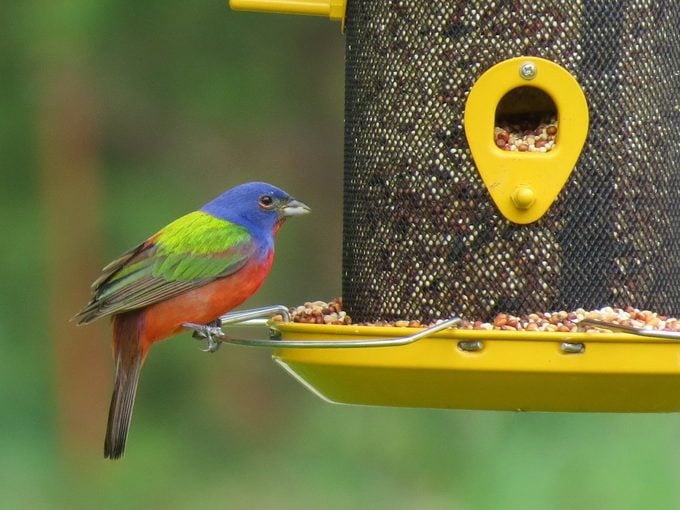
Males have bright blue heads, red bodies and yellow-green backs, with darker green on the wings. They develop this bold color in the fall of their second year.
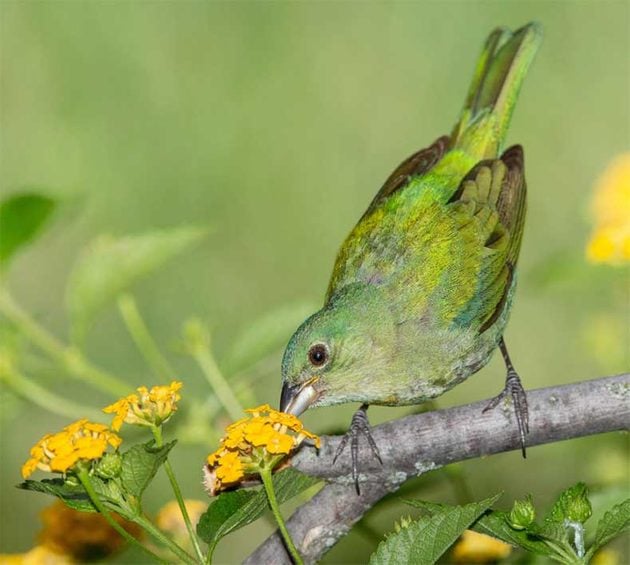
Females and juveniles sport a lime green hue, an unusual color among North American feeder birds.
Blue grosbeak vs indigo bunting: how to tell them apart.
Painted Bunting Nest
During the breeding season, males are extremely territorial. They stake out an area of about 3 to 8 acres and defend it vigorously from other males. Vicious fights may ensue, with males wounding other males. Females may even get caught up in the fray. Together the male and female choose a nest site, generally in dense vegetation about 3 to 6 feet off the ground.
Females build the nests and lay a clutch of three or four pale eggs speckled with brown, which they incubate alone for about 11 days. Once the eggs hatch, the female stays busy feeding her young brood, again with no help from her mate. The hatchlings fledge the nest in about nine days, and females often lay a second clutch of eggs soon after.
Learn how to identify a varied bunting.
Painted Bunting Song
Once the territory is secure, males sing and spread their feathers to attract a mate. Only male painted buntings sing songs like: graffiti graffiti spaghetti-for-two. If you think you see a plain green female bursting into song, it’s most likely an immature male in his first year.
Bird songs courtesy of the Cornell Lab of Ornithology
What Do Painted Buntings Eat?
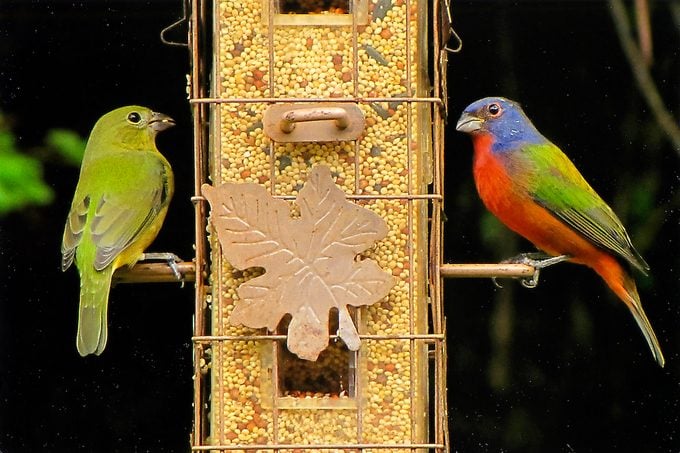
“Indigo buntings love the black oil sunflower seeds I put out. But their more colorful relative, painted buntings, do not. How can I attract them?” asks reader Kara Minter Petal, Mississippi.
Birding experts Kenn and Kimberly Kaufman say, “In terms of food, painted buntings are seedeaters. For those fortunate enough to have them on their list of yard birds, white millet seems to be the seed of choice. Birdbaths with moving water—a dripper or mister, for example— can also help entice these multicolored marvels to your yard.”
Painted buntings are wary and easily scared off, so hang a feeder with a protective cage around the tube to discourage larger bully birds.
During the breeding season, they switch to protein-heavy insects for extra energy. Females may steal bugs caught in spiderwebs, and even pull webs down to feast on the spiders that built them.
Once breeding season ends, they return to seeds, especially ones they find on or near the ground.
How to Attract Painted Buntings
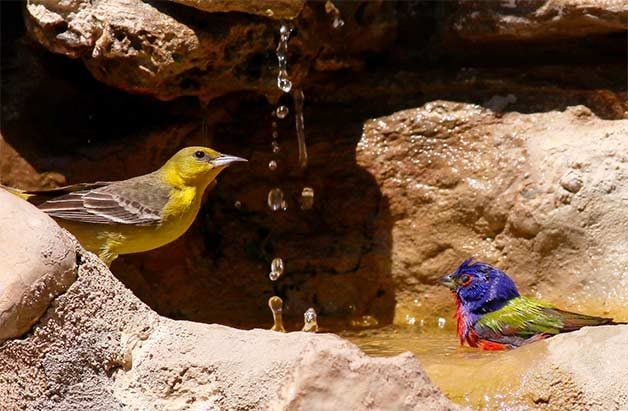
Kenn and Kimberly say, “You’d think a bird that looks like a feathered rainbow would want to be seen, right? But painted buntings can be shy and difficult to attract to backyards. For starters, they prefer habitat with a lot of cover, so areas with low, dense shrubbery are more appealing.”
Ensure that your yard provides the right habitat by planting plenty of native shrubs and grasses. Painted buntings nest close to the ground in low-growing vegetation, so having these on your property raise your chances of bringing in a breeding pair.
Painted buntings also like to have an easy source of water to visit.
Patience is the key with painted buntings. They may be slow to come around, but once they find a constant food source, water and protective shelter, they’re likely to return frequently.
Learn what snow buntings look like and where to find them.
Painted Bunting Range and Migration
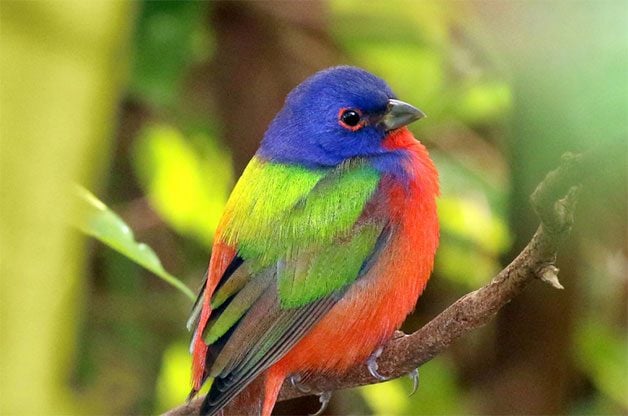
Look for painted buntings in the south central and southeastern states. They have two distinct summer breeding areas. One covers a large area from Texas to Mississippi and north to Kansas, and another is centered in the coastal Carolinas.
Painted buntings undertake a short winter migration to Florida, Mexico and Central America, when they gather in small mixed flocks with other birds, such as their indigo bunting cousins.
Editor’s note: Look for painted buntings in Florida. It’s the only state that consistently has a spring and summer breeding population and a winter population.
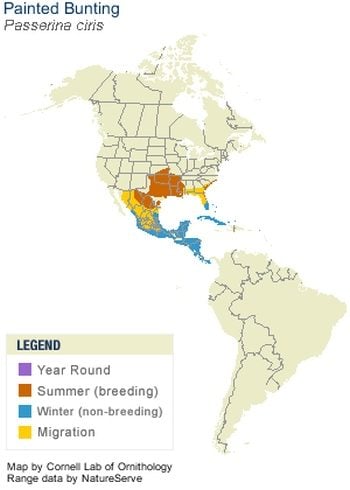
Next, learn about lazuli buntings: vibrant jewels of the west.
Why Trust Us
For nearly 30 years, Birds & Blooms, a Trusted Media Brand, has been inspiring readers to have a lifelong love of birding, gardening and nature. We are the #1 bird and garden magazine in North America and a trusted online resource for over 15 million outdoor enthusiasts annually. Our library of thousands of informative articles and how-tos has been written by trusted journalists and fact-checked by bird and garden experts for accuracy. In addition to our staff of experienced gardeners and bird-watchers, we hire individuals who have years of education and hands-on experience with birding, bird feeding, gardening, butterflies, bugs and more. Learn more about Birds & Blooms, our field editor program, and our submission guidelines.
Sources
- Kenn and Kimberly Kaufman, official birding experts for Birds & Blooms
- The Cornell Lab of Ornithology
